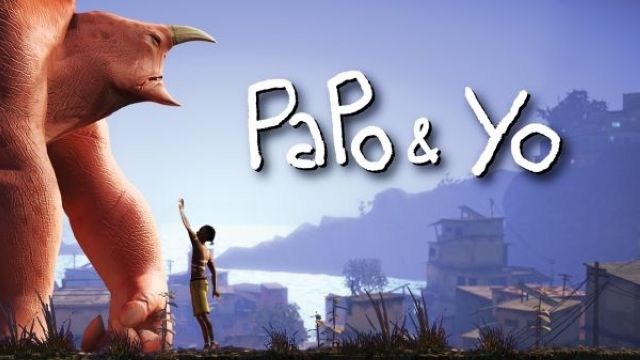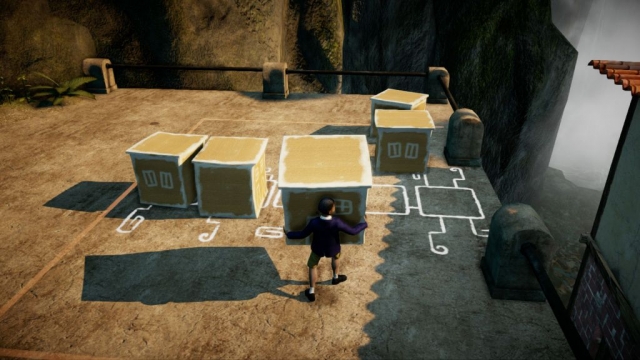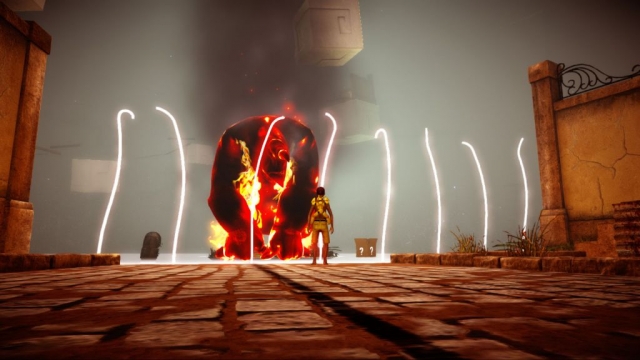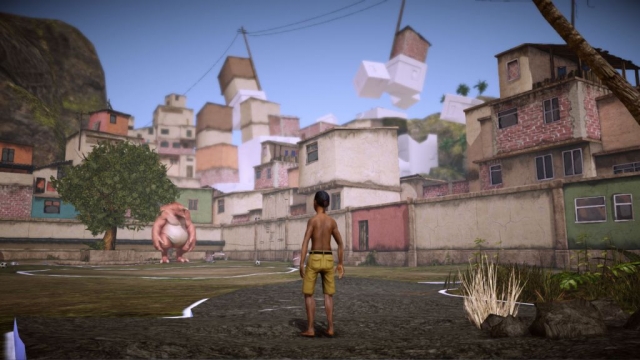Papo & Yo Review

Papo & Yo (which means “Father and Me” in Spanish) is an action-adventure from Canadian developer Minority Media. In it you control a young boy named Quico as he creates a fantasy version of his world in order to escape the abusiveness of his father. The father appears as a hulking Monster in the fantasy world, and while Monster is usually friendly and playful, sometimes it consumes a poisonous frog (aka alcohol) and flies into an uncontrollable rage. Quico uses the fantasy world to search for a cure for Monster.
Most of Papo & Yo takes place in the fantasy world, which looks a lot like a third world country (perhaps in South America), except for the fact that buildings can sprout legs and walk around, chalk can be used to create doorways in walls, and the laws of physics don’t always apply (there are a couple of Inception-like scenes where the landscape twists and turns in interesting ways). The artistry of the game is its highlight; you certainly won’t mistake Papo & Yo for any other game you’ve ever played.
The interface in Papo & Yo is standard fare — which is a good thing since you’re dumped into the game without any sort of manual or tutorial. You use the WASD keys to move Quico around, the mouse to steer, the mouse buttons or the E key to perform actions, the spacebar to jump, and the Q key to launch Quico’s toy robot Lula at a target. You can also use Lula’s thrusters to help you during your jumps (by pressing the spacebar in the middle of a jump) to extend the distance you travel, and you can climb onto Monster’s bouncy belly to jump much higher than normal.
The puzzles in Papo & Yo involve running, jumping, climbing, and pulling levers. There aren’t any inventory objects to worry about or people to talk to. Most of the puzzles don’t require a lot of thought. All of the magical elements in the fantasy world have chalk outlines, making them easy to spot, and so it’s always clear where you have to go next. The jumping sequences are also straightforward. You can’t die in the game, and if you manage to jump somewhere that you can get out of, then you’re simply teleported back to a safe spot so you can try again.
As an example of the puzzles, early on you’re tasked with crossing a large gap. The gap is much too wide to jump, and so you have to reposition some nearby buildings to create a bridge. You control the buildings by moving around cardboard boxes (each box represents a building), and the puzzle might be at least a little bit tricky except for the fact that there are chalk squares on the ground, and all you have to do is move the boxes onto the squares to complete the puzzle. There are also clue boxes for most puzzles, which give you hints for what to do.
One of the core strengths of Papo & Yo should be its emotional pull, since it deals with a boy trying to deal with a difficult situation, but I found this component of the game to be surprisingly underdeveloped. The problem is, since the game takes place almost entirely in the fantasy world, you never learn anything about Quico and his father, and their relationship is simply left to your imagination (oddly, a trailer for the game sets up the relationship pretty well, and demonstrates why Quico flees into the fantasy world, but this video sequence isn’t included in the game). As a result, Monster never really seems like a menace who needs to be cured, and I was far more worried about Lula while I was playing the game.
Finally, Papo & Yo is fairly short, even by adventure game standards. Because the puzzles and action sequences are straightforward, I only got tripped up in a couple of places, and it only took me about five hours to complete the game. However, after finishing Papo & Yo once, if you play it again then you can search for hats (there are 25 in total) as well as solve the puzzles, and so there might be some replay value for you. I started over and found a pair of hats, but I quickly decided that searching for hats wasn’t fun enough to make it worthwhile to repeat everything else.
Overall, Papo & Yo is an interesting game — especially visually — and it’s also a memorable game, but I don’t know that I’d call it a good game. The puzzles are largely easy, the story elements are largely missing, and the playing time isn’t large at all. Still, Papo & Yo is only priced at $15, so it might be worthwhile to pick up just to try something different.
Reviewed By: Steven Carter
Publisher: Minority Media
Rating: 73%
——————————————————————————–
This review is based on a digital copy of Papo & Yo for the PC provided by Minority Media.
 Game Over Online
Game Over Online
















